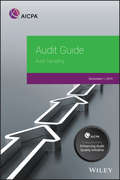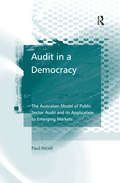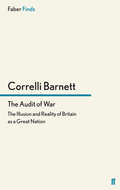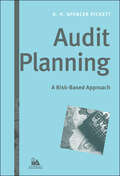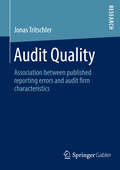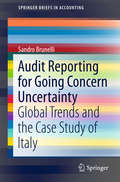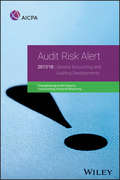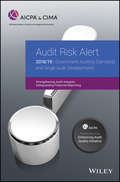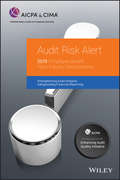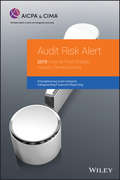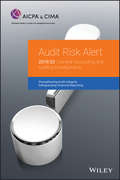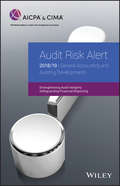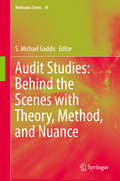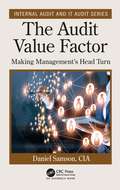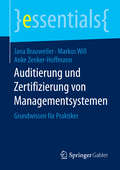- Table View
- List View
Audit Guide: Sampling 2019 (AICPA Audit Guide)
by AICPAUpdated as of December 1, 2019, this guide continues to be an indispensable resource packed with information on sampling requirements and methods. It introduces statistical and nonstatistical sampling approaches, and features case studies illustrating the use of different sampling methods, including classical variables sampling and monetary unit sampling, in real-world situations.
Audit in a Democracy: The Australian Model of Public Sector Audit and its Application to Emerging Markets
by Paul NicollExploring the role of public sector audit in emerging democracies and developing countries, this book provides an account of the relationship between the public sector auditor, the legislature and executive government. In particular, it introduces public sector audit's capacity to assess government agencies' compliance with the law and their management of taxpayer or internationally funded programs and services. The volume: ¢ Explores the Australian model of public sector audit. ¢ Provides a definition of a supreme Audit Institution (SAI) and the role and responsibilities of the public sector auditor. ¢ Examines the authority necessary for the SAI to function effectively. ¢ Discusses likely future reform of the SAI's legal framework. ¢ Illustrates how audit can be used to strengthen democratic institutions in emerging market economies. It will be of use to researchers, academics and students interested in the critical issues surrounding audit in general and public sector audit in particular. It will also be a valuable guide to practitioners in this area.
Audit in a Democracy: The Australian Model of Public Sector Audit and its Application to Emerging Markets
by Paul NicollExploring the role of public sector audit in emerging democracies and developing countries, this book provides an account of the relationship between the public sector auditor, the legislature and executive government. In particular, it introduces public sector audit's capacity to assess government agencies' compliance with the law and their management of taxpayer or internationally funded programs and services. The volume: ¢ Explores the Australian model of public sector audit. ¢ Provides a definition of a supreme Audit Institution (SAI) and the role and responsibilities of the public sector auditor. ¢ Examines the authority necessary for the SAI to function effectively. ¢ Discusses likely future reform of the SAI's legal framework. ¢ Illustrates how audit can be used to strengthen democratic institutions in emerging market economies. It will be of use to researchers, academics and students interested in the critical issues surrounding audit in general and public sector audit in particular. It will also be a valuable guide to practitioners in this area.
Audit In The Mental Health Service
by Firth-Cozens JennyAt last, a book to take practitioners in the mental health field through the various steps involved in successful clinical audit. This book, including its team and individual exercises, is designed to help select topics for audit, to understand the methods most appropriate, to set standards, understand the significance of outcomes, and to bring about changes as a result. It is a practical guide to the analysis of health care, both for those working within a professional group, and for those in multidisciplinary teams. The book will be invaluable for all mental health professionals - psychiatrists, psychologists, nurses, occupational therapists, psychiatric social workers - and purchaser or provider managers interested in clinical audit and the measurement of quality more generally.
Audit In The Mental Health Service
by Firth-Cozens JennyAt last, a book to take practitioners in the mental health field through the various steps involved in successful clinical audit. This book, including its team and individual exercises, is designed to help select topics for audit, to understand the methods most appropriate, to set standards, understand the significance of outcomes, and to bring about changes as a result. It is a practical guide to the analysis of health care, both for those working within a professional group, and for those in multidisciplinary teams. The book will be invaluable for all mental health professionals - psychiatrists, psychologists, nurses, occupational therapists, psychiatric social workers - and purchaser or provider managers interested in clinical audit and the measurement of quality more generally.
The Audit of War: The Illusion and Reality of Britain as a Great Nation (Pride and Fall sequence #2)
by Correlli BarnettCorrelli Barnett described his Audit or War as an 'operational study' to 'uncover the causes of Britain's protracted decline as an industrial country since the Second World War.' First published in 1986, the book swiftly became one of the most controversial and influential historical works of its time.'[The Audit of War] argued that British industry during the Second World War was scandalously inefficient, a situation Barnett blamed on an establishment more concerned with welfare than with industry, technology or the capacity of the nation to fight a war... Alan Clark records approvingly that Mrs Thatcher herself read it...' David Edgerton, London Review of Books'A stimulating polemic.' Times Literary Supplement'A formidable book, essential reading.' Asa Briggs, Financial Times
Audit Planning: A Risk-Based Approach (IIA (Institute of Internal Auditors) Series)
by K. H. PickettMore now than ever before, auditing is in the spotlight; legislators, regulators, and top executives in all types of businesses realize the importance of auditors in the governance and performance equation. Previously routine and formulaic, internal auditing is now high-profile and high-pressure! Being an auditor in today's complex, highly regulated business environment involves more than crunching the numbers and balancing the books-it requires ensuring that appropriate checks and balances are in place to manage risk throughout the organization. Designed to help auditors in any type of business develop the essential understanding, capabilities, and tools needed to prepare credible, defensible audit plans, Audit Planning: A Risk-Based Approach helps auditors plan the audit process so that it makes a dynamic contribution to better governance, robust risk management, and more reliable controls. Invaluable to internal auditors facing new demands in the workplace, this book is also a "hands-on" reference for external auditors, compliance teams, financial controllers, consultants, executives, small business owners, and others charged with reviewing and validating corporate governance, risk management, and controls. The second book in the new Practical Auditor Series, which helps auditors get down to business, Audit Planning: A Risk-Based Approach gives new auditors principles and methodologies they can apply effectively and helps experienced auditors enhance their skills for success in the rapidly changing business world.
Audit Quality: Association between published reporting errors and audit firm characteristics
by Jonas TritschlerArising from the author’s experience as a practicing CPA, this book is quite different from other research in this field, as it confronts the subject of audit quality from a pragmatic perspective. The first goal of Jonas Tritschler is to develop an audit quality metric on national audit firm level. Financial reporting errors, as detected by the German enforcement institutions during examinations, which subsequently are published in the German Federal Gazette by the involved companies, are the data basis for this measurement. Using the developed audit quality metric, the second goal of this study is to analyze audit quality differences of selected audit firms by comparing their deployed audit input factors such as employee’s competence (ratio of certified professionals to total audit staff), experience of employees (average tenure of employees in years) and client-specific experience (client fluctuation rate). Results indicate a correlation between audit quality according to the developed metric and the operationalized audit input factors mentioned above.
Audit Reporting for Going Concern Uncertainty: Global Trends and the Case Study of Italy (SpringerBriefs in Accounting)
by Sandro BrunelliThis book employs a narrative analytical approach to explore all aspects of the debate surrounding auditor reporting on going concern uncertainty worldwide. In-depth analysis of significant academic studies and of regulatory perspectives is combined with an illuminating empirical study in the Italian context. The book opens by discussing the assessment of going concern for accounting and auditing purposes. It is examined how going concern is considered in the FASB and IASB accounting standards and how auditors in the PCAOB and IAASB environments should verify its presence in financial statements and report on it in the audit report. Accounting and auditing in relation to going concern in other jurisdictions are also addressed. Research into the determinants, accuracy, and consequences of going concern opinions (GCO) is then thoroughly reviewed, with separate examination of studies and trends in the United States, Europe, and the rest of the world. In the third part of the book, interesting evidence from the Italian Stock Market, including investor reactions to GCOs during the period 2008–2014, is presented and evaluated. The book will be of interest to academics, regulators, and practitioners alike.
Audit Risk Alert: General Accounting and Auditing Developments, 2017/18 (AICPA)
by AICPAUpdated annually, this useful resource contains a description of all recent auditing, accounting and regulatory developments to ensure that the accountant has a robust understanding of the business, economic, and regulatory environments in which they and their clients operate. In addition, this alert ensures that the accountant has a full understanding of emerging practice issues, with targeted analysis of new developments and how they may affect your engagements, including: • Recent Economic Trends • Recent Legislative and PCAOB Developments • Developments in Peer Review • Recent Ethics Interpretations It also contains new accounting and auditing guidance related to derivatives and hedging, service concession agreements, discontinued operations, stock compensation, and more
Audit Risk Alert: Government Auditing Standards and Single Audit Developments: Strengthening Audit Integrity 2018/19 (AICPA)
by AICPAThis Audit Risk Alert highlights areas of change in audits performed under the Uniform Guidance, focusing on areas which may be challenging or frequently misunderstood. It also discusses emerging practice issues and current developments related to entities subject to an audit performed under Government Auditing Standards and the OMB Uniform Guidance and provides information to help you identify significant risks that may affect an audit of entities receiving federal awards. In addition, this alert provides a summary of revision found in the 2018 Yellow Book. Updates include: The 2018 Yellow Book USDA Rural Development Dept of Education Housing and Urban Development
Audit Risk Alert: Employee Benefit Plans Industry Developments, 2019 (AICPA)
by AICPAThe increasing complexity of employee benefit plan auditing and focus by the Department of Labor have resulted in significant pressure for CPAs and firms performing EBP audits. To help CPAs meet the challenge of performing quality audits in this unique and complex area, the AICPA has developed this alert to assist in identifying current sources of risk within EBP audit engagements. Written by a task force consisting of current and former employee benefit plan expert panel members, this alert features discussions on new developments and issues that auditors may face in their current audits, as well as a look at what's in the pipeline that may affect your engagements. Updates in 2019: FASB ASU No. 2017-06, Employee Benefit Plan Master Trust Reporting FASB ASU No. 2018-09, Codification Improvements FASB ASU No. 2018-13, Fair Value Measurement (Topic 820), Disclosure Framework–Changes to the Disclosure Requirements for Fair Value Measurement
Audit Risk Alert: Not-for-Profit Entities Industry Developments, 2019 (AICPA Audit and Accounting Guide)
by AICPANot-for-profit auditor have a lot to consider as they navigate the pace of change in today's complex business environment. Many finance professionals serving the nonprofit sector are challenged with implementation of significant new accounting standards under U.S. GAAP, such as revenue recognition and accounting for not-for-profit grants and contracts. Created for nonprofit finance and accounting staff, auditors, and board members alike, this alert features the most important developments affecting not-for-profit entities and the key issues auditors may face. This guide covers all the changes on the horizon, including business environment issues like: Cybersecurity and outsourcing Accounting and auditing challenges (e.g., the implementation of FASB's not-for-profit financial statement presentation) Revenue recognition Leases standards Delivered in an easily digestible format, this alert also covers legislative and regulatory issues such as unrelated business income tax, the "parking tax," and changes to IRS Form 990-T, as well as a discussion of the upcoming changes to the auditor's report.
Audit Risk Alert: Government Auditing Standards and Single Audit Developments: Strengthening Audit Integrity 2018/19 (AICPA)
by AICPAThis Audit Risk Alert highlights areas of change in audits performed under the Uniform Guidance, focusing on areas which may be challenging or frequently misunderstood. It also discusses emerging practice issues and current developments related to entities subject to an audit performed under Government Auditing Standards and the OMB Uniform Guidance and provides information to help you identify significant risks that may affect an audit of entities receiving federal awards. In addition, this alert provides a summary of revision found in the 2018 Yellow Book. Updates include: The 2018 Yellow Book USDA Rural Development Dept of Education Housing and Urban Development
Audit Risk Alert: Employee Benefit Plans Industry Developments, 2019 (AICPA)
by AICPAThe increasing complexity of employee benefit plan auditing and focus by the Department of Labor have resulted in significant pressure for CPAs and firms performing EBP audits. To help CPAs meet the challenge of performing quality audits in this unique and complex area, the AICPA has developed this alert to assist in identifying current sources of risk within EBP audit engagements. Written by a task force consisting of current and former employee benefit plan expert panel members, this alert features discussions on new developments and issues that auditors may face in their current audits, as well as a look at what's in the pipeline that may affect your engagements. Updates in 2019: FASB ASU No. 2017-06, Employee Benefit Plan Master Trust Reporting FASB ASU No. 2018-09, Codification Improvements FASB ASU No. 2018-13, Fair Value Measurement (Topic 820), Disclosure Framework–Changes to the Disclosure Requirements for Fair Value Measurement
Audit Risk Alert: Not-for-Profit Entities Industry Developments, 2019 (AICPA Audit and Accounting Guide)
by AICPANot-for-profit auditor have a lot to consider as they navigate the pace of change in today's complex business environment. Many finance professionals serving the nonprofit sector are challenged with implementation of significant new accounting standards under U.S. GAAP, such as revenue recognition and accounting for not-for-profit grants and contracts. Created for nonprofit finance and accounting staff, auditors, and board members alike, this alert features the most important developments affecting not-for-profit entities and the key issues auditors may face. This guide covers all the changes on the horizon, including business environment issues like: Cybersecurity and outsourcing Accounting and auditing challenges (e.g., the implementation of FASB's not-for-profit financial statement presentation) Revenue recognition Leases standards Delivered in an easily digestible format, this alert also covers legislative and regulatory issues such as unrelated business income tax, the "parking tax," and changes to IRS Form 990-T, as well as a discussion of the upcoming changes to the auditor's report.
Audit Risk Alert: General Accounting and Auditing Developments, 2017/18 (AICPA)
by AICPAUpdated annually, this useful resource contains a description of all recent auditing, accounting and regulatory developments to ensure that the accountant has a robust understanding of the business, economic, and regulatory environments in which they and their clients operate. In addition, this alert ensures that the accountant has a full understanding of emerging practice issues, with targeted analysis of new developments and how they may affect your engagements, including: • Recent Economic Trends • Recent Legislative and PCAOB Developments • Developments in Peer Review • Recent Ethics Interpretations It also contains new accounting and auditing guidance related to derivatives and hedging, service concession agreements, discontinued operations, stock compensation, and more
Audit Risk Alert: General Accounting and Auditing Developments 2019/2020 (AICPA)
by AICPAThis alert provides auditors with an overview of recent economic, industry, technical, regulatory, and professional developments that may affect how auditors conduct audits and other engagements. An entity’s internal management can also use this alert to address areas of audit concern. Updates include: Economic and Industry Developments Legislative and Regulatory Developments Audit and Attestation Issues and Developments Revenue Recognition New Lease Standard Accounting for Financial Instruments Recent AICPA Independence and Developments
Audit Risk Alert: General Accounting and Auditing Developments 2019/2020 (AICPA)
by AICPAThis alert provides auditors with an overview of recent economic, industry, technical, regulatory, and professional developments that may affect how auditors conduct audits and other engagements. An entity’s internal management can also use this alert to address areas of audit concern. Updates include: Economic and Industry Developments Legislative and Regulatory Developments Audit and Attestation Issues and Developments Revenue Recognition New Lease Standard Accounting for Financial Instruments Recent AICPA Independence and Developments
Audit Risk Alert: General Accounting and Auditing Developments 2018/19 (AICPA)
by AICPAContaining descriptions of all recent auditing, accounting and regulatory developments, this 2018 alert will ensure that accountants have a robust understanding of the business, economic, and regulatory environments in which they and their clients operate. In addition, accountants will gain a full understanding of emerging practice issues, with targeted analysis of new developments and how they may affect their engagements, including: Recent Economic Trends Recent Legislative and PCAOB Developments Developments in Peer Review Recent Ethics Interpretations This useful resource also contains new accounting and auditing guidance related: Derivatives and Hedging Service Concession Agreements Discontinued Operations Stock Compensation
Audit Risk Alert: General Accounting and Auditing Developments 2018/19 (AICPA)
by AICPAContaining descriptions of all recent auditing, accounting and regulatory developments, this 2018 alert will ensure that accountants have a robust understanding of the business, economic, and regulatory environments in which they and their clients operate. In addition, accountants will gain a full understanding of emerging practice issues, with targeted analysis of new developments and how they may affect their engagements, including: Recent Economic Trends Recent Legislative and PCAOB Developments Developments in Peer Review Recent Ethics Interpretations This useful resource also contains new accounting and auditing guidance related: Derivatives and Hedging Service Concession Agreements Discontinued Operations Stock Compensation
Audit Studies: Behind the Scenes with Theory, Method, and Nuance (Methodos Series #14)
by S. Michael GaddisThis book offers practical instruction on the use of audit studies in the social sciences. It features essays from sociologists, economists, and other experts who have employed this powerful and flexible tool. Readers will learn how to implement an audit study to examine a variety of questions in their own research. The essays first discuss situations where audit studies are the most effective. These tools allow researchers to make strong causal claims and explore questions that are often difficult to answer with observational data. Audit studies also stand as the single best way to conduct research on discrimination. The authors highlight what these studies have uncovered about labor market processes in the past decade. The next section gives some guidance on how to design an audit study. The essays cover the difficult task of getting a study through an institutional review board, the technical setup of matching procedures, and statistical power and analysis techniques. The last part focuses on more advanced aspects. Coverage includes understanding context, what variables may signal, and the use of technology. The book concludes with a discussion of challenges and limitations with an eye towards the future of audit studies.“Field experiments studying and testing for housing and labor market discrimination have, rightly, become the dominant mode of discrimination-related research in economics and sociology. This book brings together a number of interesting and useful perspectives on these field experiments. Many different kinds of readers will find it valuable, ranging from those interested in getting an overview of the evidence, to researchers looking for guidance on the nuts and bolts of conducting these complex experiments.”David Neumark, Chancellor’s Professor of Economics at the University of California – Irvine“For decades, researchers have used experimental audit studies to uncover discrimination in a variety of markets. Although this approach has become more popular in recent years, few publications provide detailed information on the design and implementation of the method. This volume provides the first deep examination of the audit method, with details on the practical, political, analytical, and theoretical considerations of this research. Social scientists interested in consuming or contributing to this literature will find this volume immensely useful.” Devah Pager, Professor of Sociology and Public Policy at Harvard University
The Audit Value Factor (Internal Audit and IT Audit)
by Daniel SamsonThe Audit Value Factor: Making Management’s Head Turn empowers readers with a systematic method to build and maintain a value-centric internal audit organization. The book explores how to identify, quantify, and articulate value for customers. It details six critical success factors: Value propositions that link directly to customer needs Fostering customer relationships using the CREATE model Talent development using the TEAM model Risk expertise that raises awareness, understanding, and action Change management and process optimization using the SMART model Data analytics that provide powerful insights to operations The Audit Value Factor offers easy to use tools and practical strategies that deliver tangible and immediate benefits for the internal audit team. Praise for The Audit Value Factor: Making Management’s Head Turn "Daniel Samson, the inspiring and forward-thinking CAE at SRI International, has created an essential guide to adding value through Internal Audit in his new book The Audit Value Factor. It's an important addition to any internal auditor's toolkit, with helpful suggestions on topics ranging from talent planning to data analytics. I highly recommend it to any internal audit professional looking to "up their game." Laurie A. Hanover, CIA, CAE Sunrun Inc. "Internal Auditors often strive for a ‘seat at the table,’ be it with Business Leaders, Senior Management, the Board, or really, any significant decision maker in an organization. In The Audit Value Factor, Dan Samson provides the roadmap to ensuring that Internal Audit gets not only that seat at the table, but also that role of a critical business partner that is valued in facilitating change and helping an organization achieve its goals." Brian Tremblay, CAE Acacia Communications "Great audit functions generate value and build leadership capacity from staff to CAE. The Audit Value Factor’s compelling examples, data, and actionable tools enable auditors at every level to build relationships of trust, ask the right questions, and deliver powerful insights to their organization." Dr. Kathryn Bingham, Executive Coach and CEO, LEADistics LLC
The Audit Value Factor (Internal Audit and IT Audit)
by Daniel SamsonThe Audit Value Factor: Making Management’s Head Turn empowers readers with a systematic method to build and maintain a value-centric internal audit organization. The book explores how to identify, quantify, and articulate value for customers. It details six critical success factors: Value propositions that link directly to customer needs Fostering customer relationships using the CREATE model Talent development using the TEAM model Risk expertise that raises awareness, understanding, and action Change management and process optimization using the SMART model Data analytics that provide powerful insights to operations The Audit Value Factor offers easy to use tools and practical strategies that deliver tangible and immediate benefits for the internal audit team. Praise for The Audit Value Factor: Making Management’s Head Turn "Daniel Samson, the inspiring and forward-thinking CAE at SRI International, has created an essential guide to adding value through Internal Audit in his new book The Audit Value Factor. It's an important addition to any internal auditor's toolkit, with helpful suggestions on topics ranging from talent planning to data analytics. I highly recommend it to any internal audit professional looking to "up their game." Laurie A. Hanover, CIA, CAE Sunrun Inc. "Internal Auditors often strive for a ‘seat at the table,’ be it with Business Leaders, Senior Management, the Board, or really, any significant decision maker in an organization. In The Audit Value Factor, Dan Samson provides the roadmap to ensuring that Internal Audit gets not only that seat at the table, but also that role of a critical business partner that is valued in facilitating change and helping an organization achieve its goals." Brian Tremblay, CAE Acacia Communications "Great audit functions generate value and build leadership capacity from staff to CAE. The Audit Value Factor’s compelling examples, data, and actionable tools enable auditors at every level to build relationships of trust, ask the right questions, and deliver powerful insights to their organization." Dr. Kathryn Bingham, Executive Coach and CEO, LEADistics LLC
Auditierung und Zertifizierung von Managementsystemen: Grundwissen für Praktiker (essentials)
by Jana Brauweiler Markus Will Anke Zenker-HoffmannJana Brauweiler, Markus Will und Anke Zenker-Hoffman erläutern Arten und Einsatzbereiche von Audits sowie die Planung, Vorbereitung, Durchführung und Auswertung sowohl von internen als auch von Zertifizierungsaudits, beispielhaft dargestellt an UMS-Audits. Außerdem wird auf Qualifikationsanforderungen von Auditoren eingegangen. Die AutorInnen schließen mit methodischen Hinweisen zur Gewährleistung eines wertschätzenden Charakters von Audits, zu Fragearten und -techniken, zur Wahrnehmung von Informationen sowie zum Umgang mit Widerständen und Einwänden bei der Auditierung.
